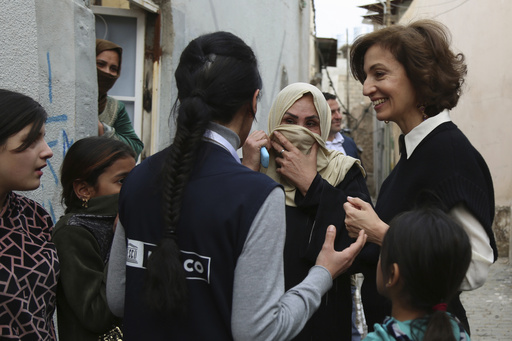
MOSUL, Iraq — For more than 850 years, the Al-Hadbaa Minaret of the Great Mosque of al-Nuri served as a prominent symbol of Mosul until its destruction by the Islamic State group in 2017. Nearly eight years after the city was liberated from IS militants, efforts to restore the minaret have commenced as part of a substantial reconstruction initiative backed by international funding aimed at revitalizing the historical fabric of Mosul.
Saad Muhammed Jarjees, a resident of the Old City of Mosul, has fond memories of the minaret, which he used to admire daily from his home. He recounted the feeling of despair when the minaret was destroyed during the conflict. “Each morning during the Islamic State’s reign, I would gaze at it and see their flag atop it,” he reminisced. “We yearned for the day that flag would be taken down, signifying our liberation. But then one morning, we woke to find the minaret completely gone.”
In collaboration with Iraqi heritage and Sunni religious authorities, UNESCO undertook the project’s restoration, employing traditional methods and materials salvaged from the destruction. For the residents of Mosul, the revival of the minaret is a matter of deep emotional significance. “This mosque signifies the essence of Mosul’s populace,” stated Mohammed Khalil Al-Assaf, an imam in the area. “Today, as we gather to witness the Al-Hadbaa Minaret, we are reminded of the beautiful memories we shared in this sacred mosque.”
An official ceremony to reopen the minaret is anticipated in the upcoming weeks, with Iraqi Prime Minister Mohammed Shia al-Sudani expected to be present. Ruwaid Allayla, the Director of the State Board of Antiquities and Heritage, expressed the importance of this landmark to the community. “The Al-Hadbaa Minaret is one of the most significant monuments for the citizens of Mosul, and it is now fully restored,” he declared. “The heritage authority ensured that authentic materials were utilized in reconstruction to maintain its unique value and authenticity, thus keeping it on UNESCO’s World Heritage list.”
Omar Taqa, the site’s engineer for the Al-Hadbaa Minaret and the Great al-Nuri Mosque, outlined the challenges faced during the restoration process, notably the removal of remnants from the war intermingled with the rubble and the need to distinguish artifacts from debris. “One of the significant hurdles during the reconstruction was disentangling war remnants from the rubble and separating artifacts,” Taqa noted. Moreover, meticulous engineering and historical studies were required to ensure that the restoration honored the original minaret’s essence.
During a recent visit to Mosul, UNESCO Director-General Audrey Azoulay toured the restored minaret, the al-Nuri Mosque, and other revitalized sites, such as the al-Hadbaa Minaret and the al-Tahira and al-Sa’aa churches. “This intervention in a post-conflict landscape is remarkable due to its complexity,” she expressed. “Eighty percent of the Old City had been obliterated. When our initial team arrived in 2018, they encountered a landscape of ruins.”
To facilitate this ambitious restoration, UNESCO mobilized $115 million, with significant contributions from the United Arab Emirates and the European Union, Azoulay mentioned.
In addition to the minaret, efforts have been made to restore Mosul’s Christian sites. Prior to the rise of IS, the city’s Christian population was approximately 50,000, many of whom left following IS’s violent takeover in 2014. Today, fewer than 20 Christian families remain in Mosul as permanent residents, with others who fled to nearby towns commuting back for church services on Sundays.
At the restored al-Tahira Church, Mar Benedictus Younan Hanno, Archbishop of Mosul for Syriac Catholics, noted that the rebuilding process transcends mere structures. “Our primary objective in reconstructing these churches is to revive the rich history of our ancestors,” said Hanno. “When Christians visit this church, they reminisce about their education, baptisms, and prayers, which may encourage their return.”
Azoulay emphasized that the sounds of church bells and choirs resuming in Mosul send a potent message. “It symbolizes the city’s return to its authentic, pluralistic identity,” she remarked. “This rebuilding signifies a hopeful moment for the future, carried out by Iraqi citizens, predominantly Muslims, eager to restore this community.”
UNESCO’s experience in Mosul is expected to inform its future efforts to restore cultural sites in other war-torn regions, including neighboring Syria, which is beginning to recover from nearly 14 years of civil conflict following the fall of former President Bashar Assad. “This initiative represents a legacy for UNESCO,” Azoulay stated, highlighting the expertise gained through this unprecedented project. “This model will be invaluable in similar future scenarios.”
While Azoulay refrained from discussing specific plans for Syria, she expressed a desire to replicate the successful restoration work done in Mosul, contingent upon political and security conditions. “The wounds of this city will take considerable time to mend,” she acknowledged. “However, this marks a beautiful beginning for a brighter future.”

